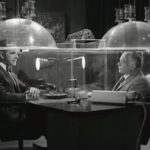The Forbidden Word – “Soundproof”
There’s a word I recommend my clients and students never use. It’s the most famous word in noise control: “soundproof”.
When I was a kid there were “waterproof” wristwatches. This implied that you could wear it to the bottom of the Marianas Trench and it would still function. Nowadays, the same watch is called “water-resistant” for obvious reasons.
Likewise the word “soundproof” can give the impression that certain products are so awesome that no sound can ever be heard through them under any circumstances. That’s magical thinking.
In practical terms, “soundproof” is an experience that occurs when sounds on one side of a partition are inaudible on the other side. The sound energy that penetrates is well below the threshold of hearing or the host space noise levels. Our brains interpret the below-threshold transmitted sound as completely inaudible, and the experience is therefore that ZERO sound has entered the space. This experience of soundproof-ness is a desirable, often difficult, but theoretically achievable noise control design goal (assuming the exterior sounds and interior environment are known). So far, so good.
The trouble starts when an uninitiated person associates the “soundproof” result with one particular product or component that was used. This in turn can fuel the belief that soundproof-ness is absolute and portable: all you have to do is deploy the amazing product, all by itself, in any circumstance or application, and audible sound will be completely extinguished.
Think I’m splittin’ hairs? The magical understanding of soundproof can cause some serious confusion that would be comical if the consequences weren’t so serious.
- An acoustical enclosure used for hearing tests sat on display in a quiet area of the factory. A potential customer (an audiologist) entered what he assumed was a “soundproof booth” and proceeded to scream at the top of his lungs. His colleague just outside the door could hear him. This is perfectly normal (it’s not intended for people to scream during hearing tests), but they smirked like they’d exposed false advertising and a “lame” product. They promised to blacken the manufacturer’s name and confidently proclaimed that they were going to buy a “real” soundproof booth from someone competent. I sometimes wonder what happened to those guys…..
- A new high school band hall was designed by an architect and the band director without the help of a noise control professional. The main rehearsal space is surrounded, for convenience, by numerous music practice rooms. The practice room doors were specified at STC 50, which the Architect and Band Director imagined to mean “soundproof” (it does not). As the building neared completion, it became obvious that practice sessions were plainly audible in the quiet rehearsal space. Tests showed that the door seals needed adjustment. But even with the seals puttied shut and the door outperforming STC 50, the band director was not satisfied because music was still audible through it. They were obviously not soundproof, no matter what the meter said. He questioned everything, including the test standard and my integrity, but not his erroneous belief.
Even under the best of circumstances, the word itself presents a fundamental problem. The dictionary.com definition says simply that “soundproof” means “impervious to sound”. And the verb form means “to cause to be soundproof”. Not a lot of wiggle room there. Many in our industry use “soundproof” as shorthand for something like “to possess or to impart excellent noise-isolating properties”. But because nothing is completely impervious to sound, and that’s exactly what people think it means, I’ve vowed to avoid using the S-word altogether (except when explaining why not to use it, of course).
Nelson Acoustics can help design quiet spaces from large performance spaces all the way down to acoustics labs below the threshold of hearing. By knowing the external noise environment and internal noise requirements, it’s possible to balance cost and performance. If you’re planning to impress your friends or colleagues by telling them your Nelson-Acoustics-designed space is “soundproof” anyway, it’s probably best to do that when I’m not around.
Copyright 2020 Nelson Acoustics
Previous entries in the series “Myths, Misunderstandings, and Magical Thinking about Noise”:
